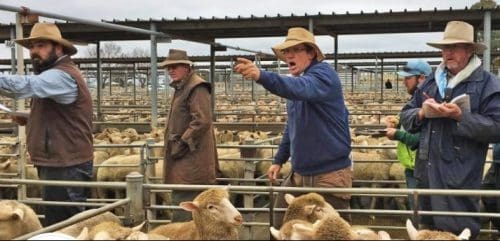
The RLA team selling at the Wagga Wagga sheep saleyards.
LAMB and wool prices face a challenging future, according to the NAB February Rural Commodities Wrap released today.
The wrap’s author, senior agribusiness economist Phin Ziebell said lamb prices have been surprisingly resilient, notwithstanding a downtrend over the past year.
“But overall risks remain weighted on the upside.
“The decade long price run-up has peaked in 2021 and is unlikely to be retraced this year, although prices remain very good by historic standards,” he said.
“With lamb a high value-add niche product on global markets, prices will be tied to the extent to which consumers cut back on luxuries as global growth slows.
“The extent to which this occurs remains to be seen,” he said.
Mr Ziebell said wool prices have improved recently, although benchmark Eastern Market Indicator fell slightly last week to A1374c/kg clean.
“But volatility is likely to remain a challenge in 2023; slowing global growth and our expectation of nervous consumers will weigh, but we expect the end of COVID zero policies will see a boost to Chinese growth later in 2023 following a challenging transition.
“It will be difficult for wool to chart a clear direction through these competing challenges.”
Global outlook remains murky
Mr Ziebell said the global economic outlook remains murky, although much recent data have surprised on the upside.
“While we continue to expect below-trend global growth in 2023, the US economy has surprised somewhat on the upside in early 2023, with a strong GDP print and very strong employment.
“Meanwhile, China’s sudden – and unexpected – abandonment of its zero COVID policies in December led the country into a disruptive transition period before what is likely to be an economic rebound across 2023,” he said.
“However, inflationary pressures remain stubbornly persistent.
“We now see a much more hawkish RBA and forecast 25 basis point hikes at each of the next three meetings, to peak at 4.1 percent in May this year.”
NAB Rural Commodities Index falls 14.5pc
NAB reported that falling Australian agricultural commodity prices have led to a 14.5 percent fall in the NAB Rural Commodities Index below year-ago levels.
The NAB February Rural Commodities Wrap today reported that lower beef cattle prices and to a lesser extent, grain prices, are the key drivers of the weakening in the index.
Mr Ziebell, said NAB sees moderately lower grain prices and further cattle price volatility this year, while prices for other major commodities have stabilised (cotton) or made gains (sugar).
“Australian wheat prices have been relatively stable since the big spring falls stabilised in December. “Australian wheat futures are currently trading in the high-300s range,” he said.
“We see prices gradually easing this year, partly as a result of our higher Australian Dollar (AUD) forecast.
“We still see an appreciating AUD this year, forecasting it to reach US74 cents by the end of June and US78 cents by the end of 2023,” Mr Ziebell said.
“Australian cattle prices continue to track sharply lower, reflecting ongoing high turnoff, constrained processor capacity and a challenging US market.
“These risks – particularly around elevated domestic cattle supply – are unlikely to abate in 2023, and we see prices continuing to fall.”
Cotton prices have stabilised in the New Year, with AUD Cotlook A around $730/bale.
“Water storage levels remain excellent although planting was challenging with a cold, wet spring. Even if 2023 is dry, the season should deliver a reasonable crop,” Mr Ziebell said.
“Sugar prices continue to post moderate gains – one of the few commodities in our Index seeing growth over the last year.
“We see the oil market outlook, combined with supply concerns, as key drivers in coming months,” he said.
“Prices are likely to remain elevated.”
Farm input prices trending lower
Mr Ziebell said fertiliser prices have dropped substantially and feed grain prices are also trending lower.
“Fertiliser has now been steadily declining from extraordinary levels in 2022.
“Our fertiliser index dropped 16.5pc month-on-month in January and is now 13.5pc below year-ago levels,” he said.
“While this is undoubtedly good news for producers, it is hard to see a return to early-2020 levels any time soon.
“Our feed grain price index has now retreated substantially from its mid-2022 highs, falling to $293/tonne in January, down 2.9pc month-on-month but still nearly 10% above year-ago levels,” Mr Ziebell said.
“While partial data for February suggests something of an increase, a big and quality downgraded winter crop and our expectations of a higher AUD should keep a lid on prices for the coming months.”
The NAB Rural Commodities Index is based on the price and production data for 28 commodities and is weighted by their relative size in Australia’s agricultural sector.

HAVE YOUR SAY